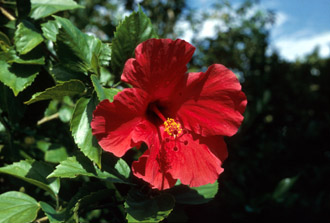Interactions with other Organisms
 Surprisingly
enough the Hibiscus rosa-sinensis’ leaves provide a great home to a
fungus called Phyllosticta discoreae, which has hyphal tips that grow
on the ends of the dead leaves of the Hibiscus rosa-sinensis. The
fungus
Phyllosticta discoreae is currently being researched for its production
of Taxol. The Taxol that is produced by the fungus Phyllosticta discoreae
is the same Taxol that is found in the
Pacific Yew Tree.
This makes the Hibiscus rosa-sinensis
the first angiosperm to have the fungus associated with Taxol produced on its
leaves. However, there is still research currently being done on this, to help
increase the production of the drug Taxol (since the fungus itself does not
produce as much Taxol is the
Pacific Yew). This mutualistic relationship is one
that could end up potentially saving lives.
Surprisingly
enough the Hibiscus rosa-sinensis’ leaves provide a great home to a
fungus called Phyllosticta discoreae, which has hyphal tips that grow
on the ends of the dead leaves of the Hibiscus rosa-sinensis. The
fungus
Phyllosticta discoreae is currently being researched for its production
of Taxol. The Taxol that is produced by the fungus Phyllosticta discoreae
is the same Taxol that is found in the
Pacific Yew Tree.
This makes the Hibiscus rosa-sinensis
the first angiosperm to have the fungus associated with Taxol produced on its
leaves. However, there is still research currently being done on this, to help
increase the production of the drug Taxol (since the fungus itself does not
produce as much Taxol is the
Pacific Yew). This mutualistic relationship is one
that could end up potentially saving lives.
 This
angiosperm is a primary producer in the ecosystem that it
resides in. A primary producer provides energy for all other
organisms in the ecosystem. The Hibiscus rosa-sinensis
provides food for the Hibiscus beetle. This beetle eats the
leaves of the Hibiscus rosa-sinensis. There are many
other organisms that live in the same habitat as the
Hibiscus rosa-sinensis.
The Hibiscus rosa-sinenesis does
not have any detrimental effects on humans. If anything the
plants help beautify their yards and provide oxygen for them
via photosynthesis.
This
angiosperm is a primary producer in the ecosystem that it
resides in. A primary producer provides energy for all other
organisms in the ecosystem. The Hibiscus rosa-sinensis
provides food for the Hibiscus beetle. This beetle eats the
leaves of the Hibiscus rosa-sinensis. There are many
other organisms that live in the same habitat as the
Hibiscus rosa-sinensis.
The Hibiscus rosa-sinenesis does
not have any detrimental effects on humans. If anything the
plants help beautify their yards and provide oxygen for them
via photosynthesis.
To visit the Medicinal Purposes click here!
To return home click here!